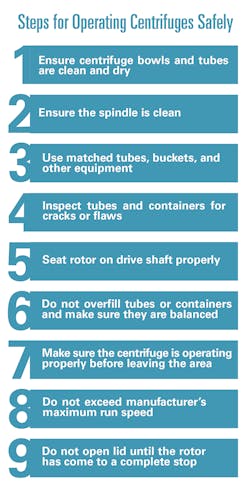Education and training remain key to safely operating centrifuges
Human error is the culprit behind most centrifuge accidents in labs, according to the Occupational Safety and Health Administration (OSHA). This means that lab managers can improve centrifuge safety at their organizations by refining operating and maintenance procedures and emphasizing staff training.
As the name centrifuge suggests, these machines use centrifugal force to separate substances. Because they operate at high speeds typically by spinning a rotor around an axis, accidents can occur if users do not follow safety steps and adhere to manufacturers’ maintenance recommendations.
One example is an accident at a lab at the Massachusetts Institute of Technology (MIT), which occurred in 1999. In that case, no one was hurt. The centrifuge rotor split down the middle, causing the machine to cease operating and automatically lock the lid, which was later opened by a technician working for the manufacturer. Although it was impossible to pinpoint the cause of the accident precisely, the technician concluded that the ages of both the rotor, which was long past its manufacturer’s recommended lifespan, and the centrifuge were to blame.1
“The most common accidents involving centrifuges involve tube breakage, many times springing from a tube imbalance. Other issues include imbalances that move the centrifuge (sometimes off the counter and onto the floor!), injuries from staff opening centrifuges (older models) before they are stopped, and electrical issues (frayed cords, etc.),” according to Dan Scungio, MT(ASCP), SLS, CQA(ASQ), better known as Dan The Lab Safety Man, a consultant based in Williamsburg, VA.
Nonetheless, centrifuge accidents are typically relatively minor, according to Scungio. “As a lab safety officer covering multiple labs, I can tell you that centrifuge accidents are not a daily occurrence. Many accidents are not reported, especially if they do not involve employee injury or exposure. Staff members shut off the centrifuge if it is imbalanced, they clean up spills or breakages, and move on with their day,” he said.
Yuliya Mikhed, PhD, Applications Specialist for Centrifugation Laboratory Products at Thermo Fisher Scientific, added that “centrifuge accidents are quite rare. There are a lot of norms and regulations that centrifuge manufacturers need to comply with before the unit can even leave the R&D floor. Regulations describe very precisely all safety features that need to be implemented to prevent any severe consequences from potential accidents,” she said.
For example, Mikhed said, in an unlikely event of a centrifuge crash – when parts of the centrifugation system, such as rotors and buckets, disintegrate – centrifuges are designed to contain all elements, so that particles do not escape from it.
There are other common safety features in newer models, Scungio said. “Most centrifuges are designed so that they cannot operate while the lid is open. Some newer models are equipped with automatic rotor recognition. This allows the centrifuge to detect a newly inserted rotor and automatically limits the speed (rpm) to the rotor’s maximum permissible value. Newer models alert users quickly when they sense load imbalances or other issues, and they will stop running to prevent a major incident,” he said.
But that does not mean that laboratory managers should be complacent, and there are steps they can take to prevent problems.Safe operating procedures
Before operating a centrifuge, staff members should make sure it is properly balanced and secure on a level surface with at least a 6-inch clearance at the sides and 4 inches at the rear of the centrifuge, the Centers for Disease Control and Prevention (CDC) recommended.
Staff members also should ensure that the centrifuge bowls and tubes are dry, the spindle is clean, and the rotor is properly seated on the drive shaft, according to OSHA.2
Balancing the load also is crucial, particularly if the machine will be only partially full. Eppendorf, a manufacturer of centrifuges, offered these tips on its website for load balancing:3
- For fixed-angle rotors – which hold tubes in a fixed angle – balance the tubes according to weight, loading the rotor symmetrically by both type of tube and mass.
- For swing-out rotors – which have multiple buckets that are not fixed to the rotor – load all rotor positions with buckets at equal weight and make sure tubes or plates are symmetrical. If the buckets do not swing smoothly, clean them and apply grease.
As Eppendorf explained on its website, “Incorrect loading can reduce the lifetime of the rotor, and uncontrolled, heavy vibration can lead to permanently damaging the centrifuge. More importantly, however, an imbalanced load can injure you or someone else. In the worst case, an imbalance can lead to a rotor crash.”
According to OSHA, staff members should inspect tubes or containers for cracks or flaws before using them, and they should not over fill them. They also should inspect o-rings, adapters, and caps for signs of wear or damage.
Once staff members start the equipment, they should stay until the centrifuge reaches the maximum rpms without balance issues or noises, Scungio recommended. When the operation is complete, they should not open the lid until the rotor has stopped completely.
Waiting before opening the lid allows the aerosols time to settle in the case of a broken tube. Because staff members may not know if a tube has broken, Eppendorf suggests they wait at least 10 minutes before opening the centrifuge, and 30 minutes if they know that a tube has broken, according to the company’s website.
OSHA noted that it is particularly important to wait at least 10 minutes after the rotor comes to a complete stop if the tubes contain infectious materials.
Regular centrifuge maintenance
In addition to proper operating procedures, regular maintenance extends the life of the equipment and ensures safe operation.
“The most common mistake is irregular cleaning and maintenance,” Thermo Fisher’s Mikhed said.
“The most important steps are cleaning, disinfecting and usage of lubricant and anti-corrosion oil for rotors and the centrifuge chamber,” she pointed out.
“We would like to mention that not all cleaning/disinfecting reagents are suitable for centrifuges. This type of equipment consists of parts made of various materials, like steel, plastic and rubber; thus, it is important to choose a proper cleaning/disinfecting solution that will neither corrode metal parts, nor shorten the lifespan of the plastic components. Usage of lubricants and anti-corrosion oil are of paramount importance not only for prolonging the lifecycle of the rotors, but also to prevent unnecessary micro-vibrations that will have a negative effect on the most sensitive samples,” she said.
The CDC recommended that labs “maintain a complete and comprehensive rotor log for every high-speed and ultracentrifuge rotor to include all user names, run dates, durations, speeds, total rotor revolutions, and any notes on rotor condition.”4 The agency also recommended that labs arrange for rotors to ”have annual stress testing and a complete certified analysis,” noting that many centrifuge manufacturers provide this service.
Manufacturers typically specify lifespans for their rotors, based on years in service or number of revolutions, and labs should not exceed those recommendations.
But operating and maintenance procedures will not be successful without adequate education for staff members.
For example, the CDC recommended that lab employees have “documented training and competency assessments on each type of centrifuge they operate. Documented instruction for each centrifuge type includes proper instrument startup and shutdown, emergency procedures and shutdown, balancing of tubes, use of safety cups and covers, rotor and container selection, requirements for high-speed and ultracentrifuges, and container fill-height limitations.”4
As Scungio said, “Consistent training for end users on the equipment’s safety features remains key.”
References:
- The centrifuge accident. Massachusetts Institutes of Technology. 1999. https://web.mit.edu/charliew/www/centrifuge.html. Accessed August 1, 2020.
- OSHA quick facts. Laboratory safety – centrifuges. Occupational Safety and Health Administration (OSHA). https://www.osha.gov/Publications/laboratory/OSHAquickfacts-lab-safety-centrifuges.pdf. Accessed August 1, 2020.
- Centrifuge safety. Eppendorf Handling Solutions. https://handling-solutions.eppendorf.com/sample-handling/centrifugation/safe-use-of-centrifuges/centrifuge-safety/. Accessed August 1, 2020.
- Miller M, Astles R, et al. Guidelines for safe work practices in human and animal medical diagnostic laboratories. Recommendations of a CDC-convened, biosafety blue-ribbon panel. Morbidity and Mortality Weekly Report. Centers for Disease Control and Prevention. January 6, 2012 / 61(01);1-101. https://www.cdc.gov/mmwr/preview/mmwrhtml/su6101a1.htm. Accessed August 1, 2020.


